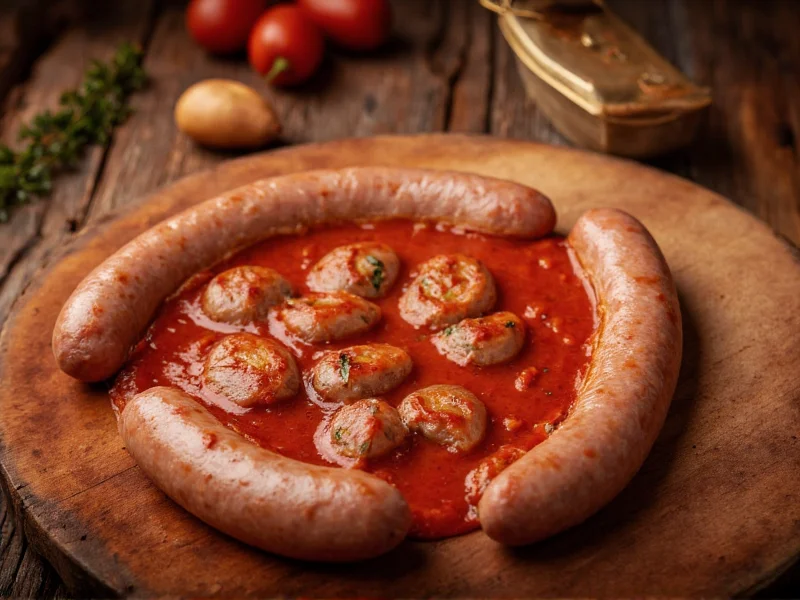The safe internal temperature for fully cooked sausages is 160°F (71°C) for pork, beef, and lamb varieties. For poultry sausages containing chicken or turkey, the required temperature is 165°F (74°C). These temperatures ensure harmful bacteria like Salmonella and E. coli are destroyed while maintaining optimal texture and flavor.
Knowing the precise internal temperature for sausages isn't just about culinary perfection—it's a critical food safety requirement. Undercooked sausages pose serious health risks, while overcooked ones become dry and unappetizing. This guide provides authoritative information on sausage cooking temperatures based on USDA food safety guidelines and professional culinary standards.
Why Temperature Matters More Than Appearance
Many home cooks rely on visual cues like color or firmness to determine when sausages are done. However, these methods are unreliable. Sausages containing nitrites can remain pink even when fully cooked, while others might appear browned on the outside but remain dangerously undercooked inside.
The only accurate way to verify doneness is by using a reliable meat thermometer. Food safety experts consistently emphasize that temperature trumps appearance every time when assessing whether sausages have reached a safe internal temperature.
Temperature Requirements by Sausage Type
Different sausage varieties require specific internal temperatures due to varying meat compositions and associated food safety risks:
| Sausage Type | Safe Internal Temperature | Minimum Hold Time |
|---|---|---|
| Pork, Beef, Lamb Sausages | 160°F (71°C) | Immediate |
| Chicken, Turkey Sausages | 165°F (74°C) | Immediate |
| Pre-cooked Sausages (heating) | 140°F (60°C) | Immediate |
| Smoked Sausages (heating) | 140°F (60°C) | Immediate |
Proper Thermometer Technique for Sausages
Using a thermometer correctly is as important as the temperature reading itself. Follow these steps for accurate results:
- Use a digital instant-read thermometer for fastest, most precise readings
- Insert the probe into the thickest part of the sausage, avoiding the casing
- Position the tip in the geometric center of the sausage
- Wait for the reading to stabilize (usually 3-5 seconds for digital thermometers)
- Check multiple sausages in the batch, as cooking can be uneven
For links, insert the thermometer sideways through the middle. For patties, insert from the top down into the center. Always clean your thermometer probe with hot, soapy water between readings to prevent cross-contamination.
Temperature Carryover and Resting Time
Understanding carryover cooking is essential for perfect sausages. When you remove sausages from heat, the internal temperature continues to rise 5-10°F (3-6°C) during resting. This phenomenon occurs because residual heat from the outer layers transfers to the center.
For best results, remove sausages from heat when they reach 155°F (68°C) for pork varieties or 160°F (71°C) for poultry sausages. Let them rest for 3-5 minutes before serving. This allows:
- Temperature to equalize throughout the sausage
- Juices to redistribute for maximum moisture retention
- Final cooking to complete to the safe temperature
Common Temperature Mistakes to Avoid
Even experienced cooks make these temperature-related errors when preparing sausages:
- Using an inaccurate thermometer - Test your thermometer in ice water (should read 32°F/0°C) or boiling water (212°F/100°C at sea level)
- Checking too early - Opening the cooking surface frequently lowers temperature and extends cooking time
- Measuring near the casing - The casing heats faster than the interior, giving false readings
- Not calibrating regularly - Digital thermometers can drift over time; check monthly
- Ignoring ambient conditions - High altitude cooking requires temperature adjustments
Food Safety Implications of Improper Cooking
Consuming undercooked sausages risks exposure to dangerous pathogens. The most common threats include:
- Salmonella - Found in raw poultry and sometimes pork; causes severe gastrointestinal illness
- E. coli - Particularly dangerous strains in undercooked ground beef products
- Trichinella - Parasite found in undercooked pork products
- Listeria - Can survive refrigeration and affects vulnerable populations most severely
These pathogens are completely destroyed when sausages reach their required safe internal temperatures. The USDA Food Safety and Inspection Service confirms that proper cooking temperature is the most reliable method to eliminate these risks.
Alternative Cooking Methods and Temperature Considerations
Regardless of your cooking method—grilling, pan-frying, baking, or boiling—the target internal temperature remains the same. However, different methods require specific temperature monitoring approaches:
- Grilling - Use indirect heat after initial searing to prevent exterior burning before interior reaches safe temperature
- Pan-frying - Maintain medium heat to allow thorough cooking without charring the exterior
- Baking - Oven temperatures vary; always verify with a thermometer rather than relying on time alone
- Boiling - Water temperature caps at 212°F (100°C), but internal sausage temperature still requires verification
For sous vide cooking, sausages can be held at precise temperatures for extended periods to achieve both safety and optimal texture. Pork sausages require 135°F (57°C) for 2 hours or 144°F (62°C) for 12 minutes to reach equivalent safety to the 160°F immediate kill temperature.
Special Considerations for Different Sausage Varieties
Certain specialty sausages have unique temperature requirements:
- Italian sausages - Typically pork-based; require 160°F (71°C) internal temperature
- Bratwurst - Can be cooked to 150-155°F (66-68°C) then finished to 160°F (71°C) for juicier results
- Breakfast sausages - Small patties cook quickly; check temperature after 8-10 minutes
- Cured sausages - Like salami, don't require cooking but should be heated to 140°F (60°C) if served warm
Always verify the specific requirements for your sausage variety, as ingredients and preparation methods affect safe cooking temperatures.











 浙公网安备
33010002000092号
浙公网安备
33010002000092号 浙B2-20120091-4
浙B2-20120091-4